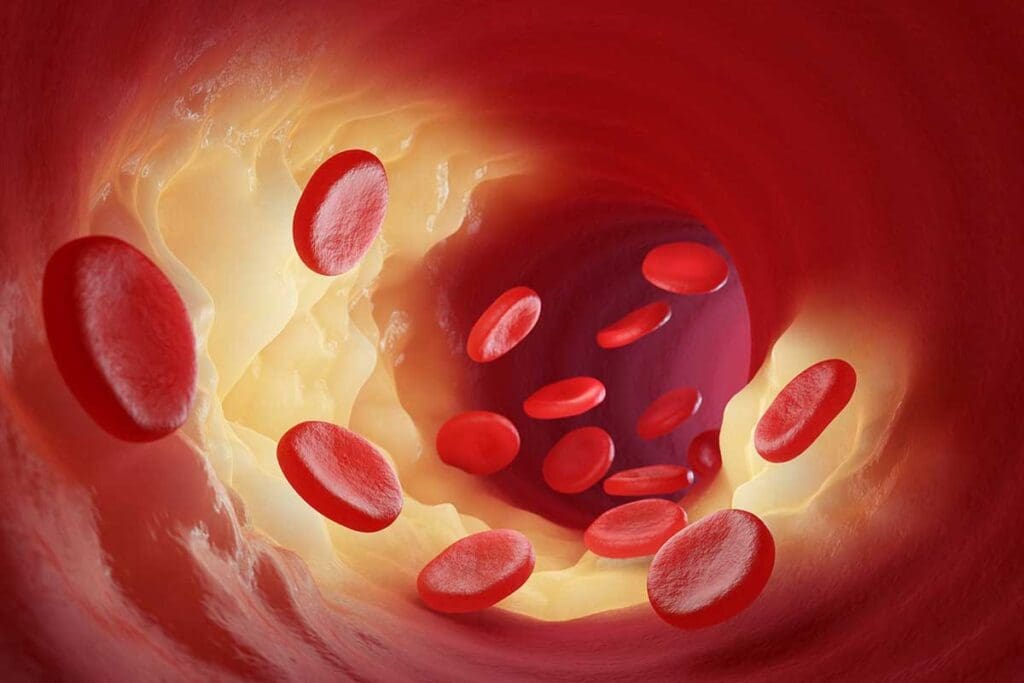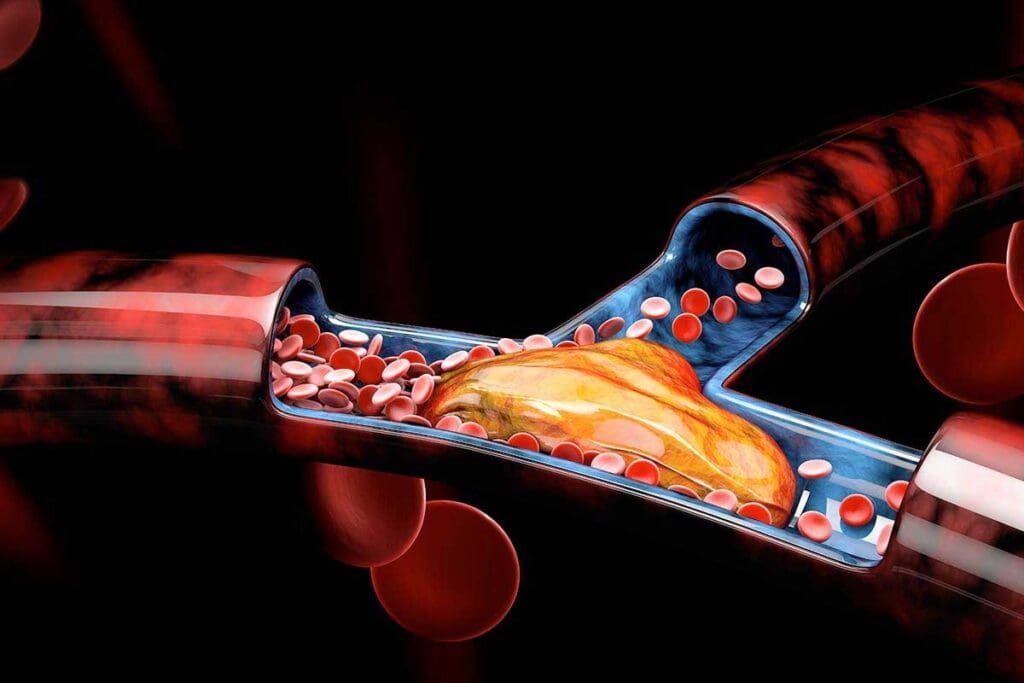Last Updated on November 17, 2025 by Ugurkan Demir

A blood clot in the neck is a serious health issue, known as jugular vein thrombosis. It’s important to spot the symptoms early to avoid serious problems.
Common signs of a blood clot in neck include neck pain, swelling, redness, and sometimes fever or trouble swallowing. If not treated, it can become life-threatening. Blood clot in neck pictures can help identify these warning signs.
Knowing the warning signs and visual symptoms, as seen in blood clot in neck pictures, helps in early detection. If you notice unusual neck pain or swelling, seek medical help right away.

A blood clot in the neck, in the jugular vein, is very dangerous. It’s called jugular vein thrombosis. This happens when a blood clot forms in the jugular vein. This vein is key for carrying blood back to the heart.
A blood clot in the neck can form in veins or arteries. A clot in a vein is called venous thrombosis. A clot in an artery is called arterial thrombosis. Jugular vein thrombosis is a type of venous thrombosis.
The jugular vein is important for draining blood from the head and neck. If a clot forms, it can block blood flow. This can cause serious problems. Clots can be caused by injury, infection, or other health issues.
Many things can lead to jugular vein thrombosis. Some common causes and risk factors include:
Neck blood clots, like those in the jugular vein, are very dangerous. They can lead to serious problems if not treated. Some risks include:
It’s important to know about the risks and causes of jugular vein thrombosis. If symptoms get worse, seek medical help. This can prevent serious and life-threatening problems.

A blood clot in the neck can show itself in different ways. It’s important to notice these signs early. This helps in getting medical help quickly.
Neck blood clots can make the neck look different. A big sign is swelling or enlargement in the area. This happens because the blood flow is blocked by the clot.
When checking the neck for blood clots, look out for these signs:
These signs mean you might have a blood clot. Keep an eye on them.
It’s important to tell a blood clot from other neck problems. For example, a neck infection or swollen lymph node can also swell and hurt. The main difference is how the swelling looks and feels.
| Condition | Common Symptoms | Differentiating Factors |
| Blood Clot | Swelling, pain, warmth, skin discoloration | Localized swelling, tenderness along the vein |
| Neck Infection | Swelling, redness, fever, pain | More diffuse swelling, presence of fever |
| Swollen Lymph Node | Tenderness, swelling, sometimes fever | Typically more localized, often associated with infection or illness |
Knowing these differences helps you check yourself right. It also helps you get the right medical care.
Neck pain and tenderness are key signs of a blood clot in the neck. This pain can feel like a dull ache or sharp stabbing. It might also make the area feel stiff or hard to move.
The pain from a neck blood clot can last a long time and get worse. It feels deep and throbbing, sometimes on just one side of the neck. It can also spread to the shoulder or jaw.
It’s hard to tell if neck pain is from a blood clot or something else. But clot pain is usually more intense. It might also come with swelling, redness, or warmth.
| Symptom | Blood Clot | Other Neck Conditions |
| Pain Characteristics | Deep, throbbing, persistent | Variable, often related to movement |
| Associated Symptoms | Swelling, redness, warmth | May include stiffness, limited mobility |
| Onset | Sudden or gradual | Often gradual, related to activity |
Severe, sudden neck pain from a blood clot is a medical emergency. Look out for signs like trouble breathing, severe headaches, or neurological problems. If you see these, get help right away.
Emergency indicators include:
Neck swelling can mean a blood clot is present. This swelling happens because the clot blocks blood flow. Fluid then builds up in the tissues around it.
Swelling is the body’s way of reacting to a blood clot. When a clot blocks a vein, blood flow stops. Fluid leaks into the tissue, causing swelling. How bad the swelling is depends on the clot’s size and how much it blocks blood flow.
Swelling from a neck blood clot can be either in one spot or spread out. Localized swelling stays in one area, while diffuse swelling covers more ground. Knowing the difference helps doctors diagnose better. For example, thoracic outlet syndrome can cause swelling over a bigger area because of blood vessel compression.
Keeping an eye on swelling is key to knowing how serious the problem is and if treatment is working. Patients can measure the swelling’s size regularly. They should also watch for other signs like pain or redness.
Watching these changes helps doctors adjust treatment plans. If swelling gets worse or doesn’t get better, it might mean they need to try something more.
Skin discoloration and warmth are signs of a possible blood clot in the neck. These symptoms happen because of the clot’s inflammation and blockage. Spotting these signs early is key for getting medical help fast.
A blood clot in the neck can make the skin pinkish, reddish, or discolored. This color change often comes with swelling. It’s a clear sign of a problem. Watch for any odd skin color changes, mainly if they’re in one spot.
The area with a blood clot might feel warmer than the rest of the neck. This warmth comes from the body’s fight against the clot. It’s important to check if the affected area is warmer than the rest of the neck.
Photographing the changes can help track symptoms and show doctors. Take clear, well-lit photos of the affected area from different angles. Make sure the photos are dated and timestamped for reference.
By noticing these symptoms and taking photos, people can understand their condition better. This helps them get medical advice on time.
Having trouble swallowing or speaking can mean you have a blood clot in your neck. This is a serious issue that needs quick action. A blood clot in this area can block or press on important parts, causing these symptoms.
A blood clot in the neck can press on the esophagus and trachea. This makes it hard to swallow or speak. The esophagus carries food to the stomach, and the trachea leads to the lungs. When a clot blocks these, it can cause difficulty swallowing or speaking.
Signs that a blood clot is pressing on vital structures include a tight throat feeling, painful swallowing, or a voice change. These signs mean the clot is affecting the esophagus or trachea. This could lead to serious problems if not treated quickly.
Signs that need immediate medical help include severe trouble swallowing or speaking, stridor (a high-pitched breathing sound), or a big voice change. These signs mean the airway is blocked. Waiting to get help could be deadly.
In summary, trouble swallowing or speaking because of a blood clot in the neck is very serious. It needs quick medical check-up. Knowing the warning signs and when to get emergency help can save lives.
Systemic symptoms, like fever, can show up with a blood clot in the neck. This might mean there’s an infection or inflammation. When a blood clot forms, it can start an inflammatory response in the body. This leads to various symptoms all over.
The body reacts to a blood clot by activating immune cells and releasing chemicals. This causes inflammation. It’s a natural way to fight off the clot. But, it can also make you feel systemic symptoms like fever, tiredness, and feeling unwell.
Besides fever, other symptoms of neck blood clots include:
These symptoms can be different in how bad they are. They might also have local symptoms like neck pain, swelling, and redness.
A high or lasting fever might mean the clot is infected or the tissues around it are infected. It’s important to see a doctor if you have a fever and other symptoms like trouble breathing, severe neck pain, or swelling that gets worse.
It’s key to understand the role of fever and other symptoms in neck blood clots. If you or someone you know has these symptoms, getting medical help is vital. A healthcare professional can give the right diagnosis and treatment.
Neck lumps can signal a blood clot. These lumps feel when you touch them. They might show a serious health issue.
A blood clot in the neck might feel like a hard, stringy bulge. This happens when the clot is in a surface vein or has caused a lot of swelling.
Key factors that influence the palpability of a neck blood clot include:
Blood clots in the neck feel firm or hard. Some people might feel pain when they touch it.
The sensation can range from a mild discomfort to a more severe pain, depending on the size of the clot and the surrounding tissue’s response.
Do a self-check if you think you might have a blood clot in your neck. Here’s how:
| Characteristics | Description |
| Texture | Firm or hardened area |
| Tenderness | May be tender to the touch |
| Location | Typically along the jugular vein or other major neck veins |
If you find any unusual lumps or have ongoing pain, see a doctor right away. They can check and figure out what’s going on.
Limited range of motion is a key symptom of a neck blood clot. A clot can cause inflammation and swelling. This leads to stiffness and reduced mobility.
A blood clot in the neck can block the normal function of muscles and joints. It causes pain and inflammation, making neck movement uncomfortable.
The onset of limited range of motion varies with clot size and location. Sometimes, it develops gradually as the clot grows. Other times, it happens suddenly if the clot forms quickly or moves.
Gradual onset is linked to a growing clot. Sudden onset suggests a more severe or acute condition.
The discomfort from a neck blood clot can differ. Some feel a dull ache, while others experience sharp pains. The pain might be constant or only happen with certain movements.
It’s important to recognize patterns of discomfort and limited mobility. If you have persistent or severe neck movement restriction, get medical help.
Healthcare providers use different tests to find out if there’s a blood clot in the neck. They look at physical exams, medical history, and imaging studies to diagnose.
There are several tests to confirm a blood clot in the neck. These include:
Treatment for a blood clot in the neck includes medicines and lifestyle changes. The main goals are to stop the clot from getting bigger, prevent more clots, and ease symptoms.
| Treatment Approach | Description |
| Anticoagulant Medications | Medications that prevent the clot from growing and reduce the risk of new clots forming. |
| Thrombolytic Therapy | Treatment that involves dissolving the clot using medications. |
| Surgical Intervention | In some cases, surgery may be necessary to remove the clot or repair damaged blood vessels. |
The time it takes to recover from a blood clot in the neck varies. It depends on the clot’s size and how well treatment works. Usually, people start feeling better in a few weeks after starting treatment.
To prevent another blood clot in the neck, making lifestyle changes is key. This includes:
Understanding how to diagnose and treat a blood clot in the neck helps patients manage their care. It also lowers the risk of future problems.
A blood clot in the neck is very serious and can be deadly if not treated fast. It’s important to know the warning signs. Look out for severe neck pain, swelling, trouble swallowing, or speaking.
Also, watch for leg or arm swelling, redness, or color changes. These signs mean you might have a blood clot. If you see these, go to the emergency room right away. A blood clot in your neck can be very dangerous and even fatal if not treated.
Knowing the dangers of a blood clot in the neck is key. Quick medical help can make a big difference. If you’re having severe symptoms, get emergency care fast. Yes, a blood clot in your neck can be deadly if not treated quickly and correctly.
A blood clot in the neck might feel like a lump or swelling. It can also cause pain or tenderness. The feeling can change based on the clot’s size and where it is.
Yes, sometimes you can feel a blood clot in your neck as a lump or swelling. But not all clots are noticeable, and some might not cause any symptoms.
Symptoms of a blood clot in the neck include neck pain and swelling. You might also see skin discoloration, warmth, and have trouble swallowing or speaking. Fever and limited movement are other signs.
Yes, a blood clot in the neck can be deadly. If it breaks loose and goes to the lungs, it can cause a pulmonary embolism. Getting medical help quickly is key if you have severe symptoms.
Images of a blood clot in the neck might show swelling or a lump. You might also see skin discoloration and signs of inflammation. The look can change based on the clot’s size and location.
To diagnose a blood clot in the neck, doctors use tests like ultrasound, CT scan, or MRI. They also do a physical exam and look at your medical history.
Jugular vein thrombosis is a blood clot in the jugular vein, a major neck vein. It can cause neck pain, swelling, and trouble swallowing.
Yes, you can have a blood clot in your neck without symptoms. But often, symptoms like neck pain, swelling, and trouble swallowing or speaking occur.
Treatment for a blood clot in the neck usually includes anticoagulant medications. These prevent the clot from growing and reduce risks. In some cases, more aggressive treatments like thrombolysis or surgery might be needed.
Risk factors for a blood clot in the neck include neck trauma or injury, cancer, recent surgery, and prolonged immobilization. Genetic conditions that affect blood clotting are also risks.
Yes, a blood clot in the neck can make swallowing or speaking hard. This happens if the clot presses on or damages nearby structures like the esophagus or nerves.
Possible complications of a blood clot in the neck include pulmonary embolism, stroke, and damage to nerves and blood vessels.
Subscribe to our e-newsletter to stay informed about the latest innovations in the world of health and exclusive offers!